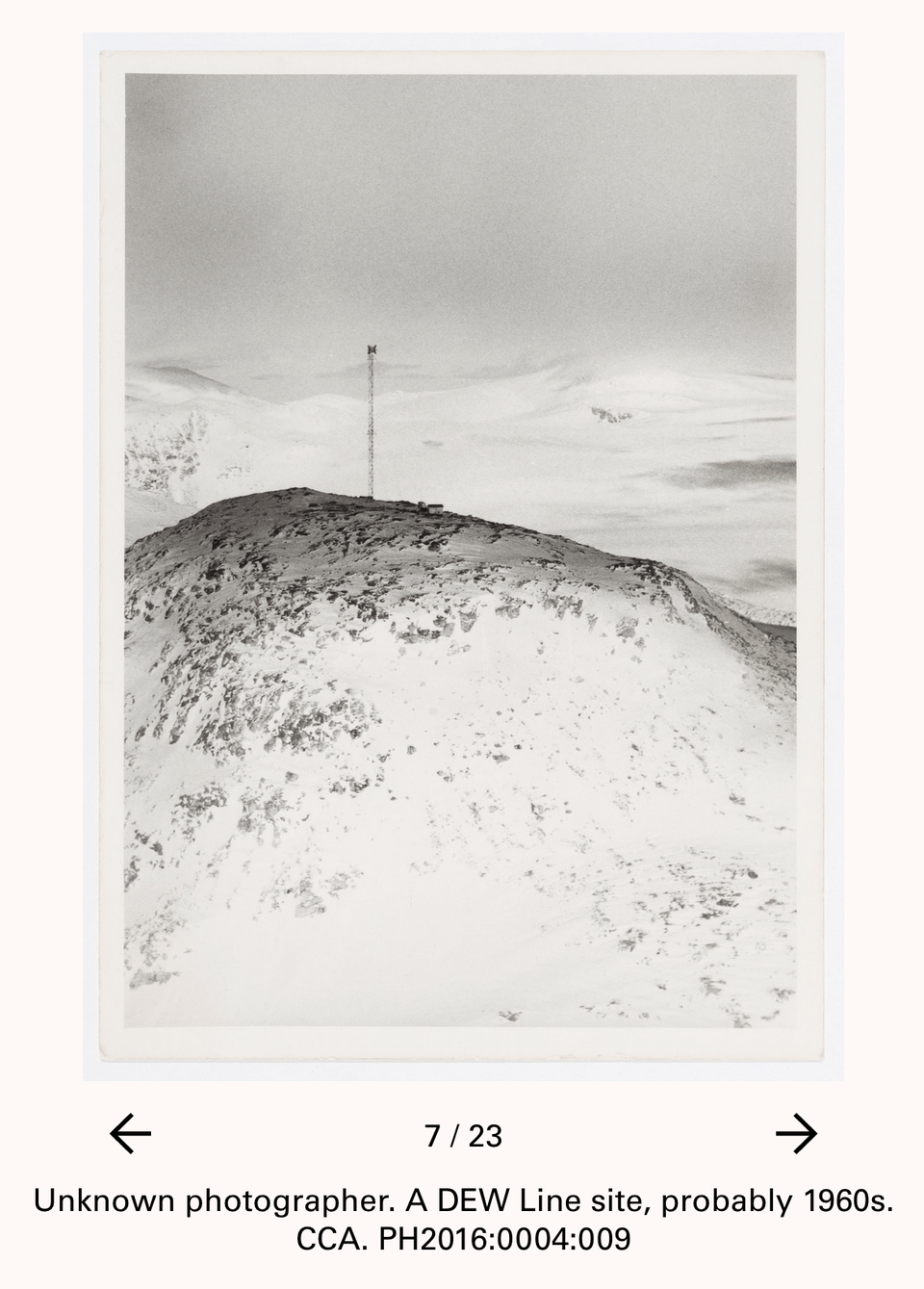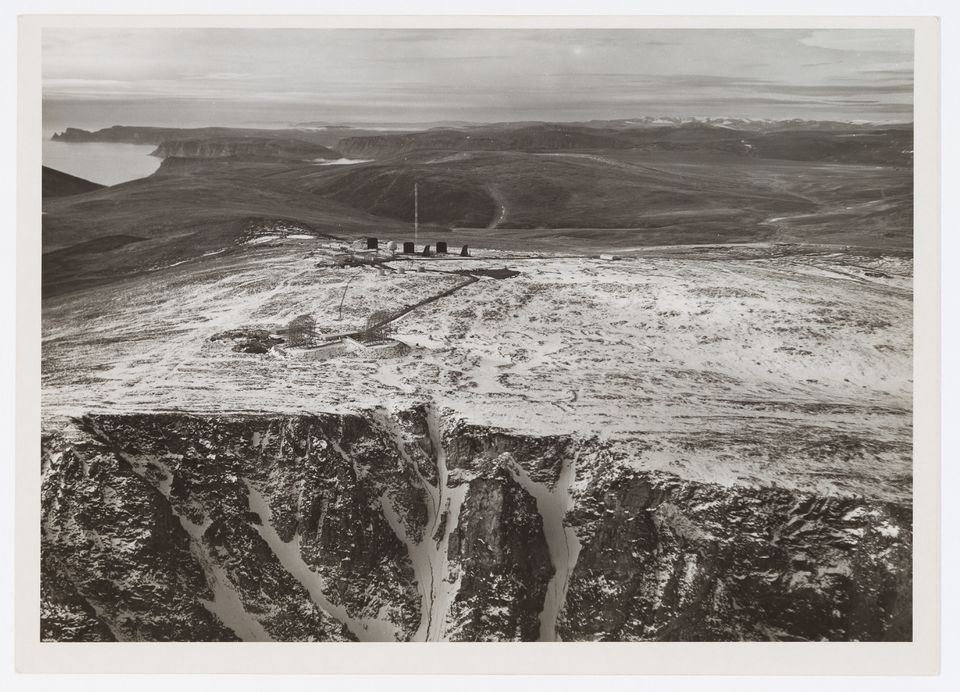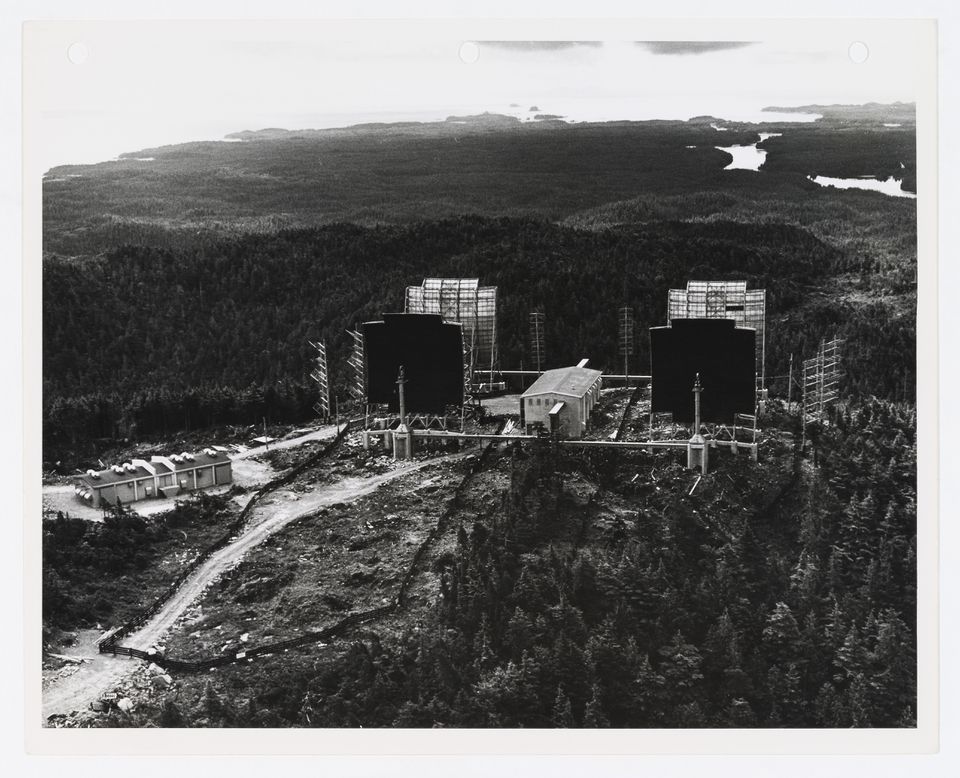Colonial Gazing, Part 1: Pictures to Places
Jonas Henderson and Emma Martin study the DEW Line photographs within the CCA’s collection
Behind every photograph exists a story. While the scope may vary, all images provide insight into both their subjects and photographers. How they are framed, who was and was not included within the image, etc. hint at a greater surrounding context. It is with this assumption that we began our research; this project is centred around the stories that photographs tell, and how the journey to uncover that story can say just as much about those photographs as the story itself. This first part of our two-part article on the DEW Line photographs within the CCA collection aims to tell two stories: that of the photographs, and that of our journey to unlock a story of colonial gazing.
In the CCA’s collection are 42 photographs that, according to what was, until recently, stated in their cataloguing, show a handful of Distant Early Warning (DEW) Line stations. The exact subjects of these photographs (i.e., the stations they feature) were hitherto unknown, and the CCA possessed no record of the stations’ locations nor of their photographer(s). In this state, these photographs offer little to no help to any curious person hoping to gain knowledge on the DEW Line–without context, they are just black and white images of unusual-looking buildings sitting on the Arctic tundra. The goal of our research was to unlock some of the mysteries behind these photographs, while also arguing how they showcase the colonization that was a result of the DEW Line, and how they offer insights into how the North is viewed by Qallunaat (non-Inuit). However, before rectifying the lack of information on these photographs, we had to begin our research by studying the history, legacy, and future of the DEW Line, to better understand the context in which these photos exist.
An example of a decontextualized DEW Line photo of the FOX C station, as seen in the article Everyone Just Left. Note how it was included in said article, despite the photo’s lack of context.
Firstly, it should be noted that this research was done from a Southern perspective, and many of the sources used were inherently colonial–most historical records of the DEW Line were written by settlers, and generally include few details regarding the Inuit. It should also be noted that some of the quotations from said colonial sources use the term “Eskimo.” While this term is justly seen as inappropriate today, we have chosen to leave it in the original quotations, as we believe it reflects Southern attitudes towards the Arctic and the Inuit at the time they were written. Apart from colonial sources, we also attempted to consult Inuit voices as often as possible during our research, and we believe that our findings are valuable, as they shed light on how the process of colonial gazing is built, particularly with regards to the dispossession of Inuit lands in the Arctic. We would also like to acknowledge that upsetting topics such as colonial violence, residential schools, and intergenerational trauma are discussed in this article. We hope that, despite the colonial elements within this research, it can act as a stepping-stone by educating Qallunaat on the legacy of the DEW Line while also providing context to items within the CCA collection. It is also our hope that this project, by properly contextualizing these items, can contribute to the ongoing process that is reconciliation.
Another contextual item worthy of note is our positionality as researchers and writers undertaking this work. Jonas’s existence is an amalgam of several ironies: being Inuit, Danish, English, and French, he is both a descendant of colonizers and the colonized; both Indigenous and a Westerner; Inuit, but raised in one of the hottest parts of the country. Emma is an Anishinaabe kwe from Chippewas of Kettle and Stoney Point First Nation. On her journey, she strongly grounds herself in respect and humility through the path of the seven grandfather teachings. These details provide transparency regarding the perspective from which this research and writing was performed: Part 1 was written by a man who identifies as an Inuk; it was also written by somebody who grew up in the South and has been influenced by both his Western and Indigenous heritage. Part 2 was written by a woman who uses photography to expose situations where systemic racism occurs to create opportunities toward change that will allow for the coexistence of humans to be in balance with Mother Earth. It is our hope that, like with the photographs, the inclusion of context will increase the value of this text as a tool for the dissemination of knowledge. We strongly believe that our role is to continue to make a difference—until difference does not matter anymore.
The construction of the DEW Line was predominantly an American undertaking, with the Canadians, anxious about questions of sovereignty in the Canadian Arctic, going to comical lengths to make it appear as if they were an equal partner with the United States on the project.1 It consisted of 63 radar stations, stretching across Alaska, Canada, Greenland, and Iceland, and was designed to alert forces in the South of Soviet bombers flying over the Arctic Sea. The project was massive and ambitious, but it was practically obsolete soon after construction was completed in the early 1950s. In 1988, the remaining operational radar stations were reorganized into the North Warning System (NWS), with several DEW Line stations simply being abandoned, infamously leaving a trail of toxic waste that would cost several hundred million dollars to clean up.2
With North American powers once again fearing Russian aggression, calls have begun for the creation of a DEW Line for the twenty-first century. However, thanks to advances in radar technology, and improvements in over-the-horizon (OTH) systems, which allow for significantly longer-ranged radar systems, it is possible that the new DEW Line could be built much further south and thus potentially have a lesser impact on Arctic life than the original.3 This time, it may be possible to satisfy the need for continental defence, and also respect Inuit sovereignty in the Arctic.
Returning to the photographs, some of the mysteries surrounding them were solved by simply looking at the reverse sides of their physical copies. Some had handwritten notes like, “My old site,” hinting at personal connections to the photographs; others were stamped with the logo of the Federal Electric Corporation (FEC), the prime contractor for the operation of the DEW Line.4 The FEC stamps were of most interest to us, as they provided a clue to the photographs’ raison d’etre: these images were all taken in an impersonal manner, displaying the station with little to no people, focusing instead on the situation and hardware. This is contrary to many other images of DEW Line stations we found in our research, which often featured groups of people and the daily lives of employees.5 The impersonal style of the CCA photographs, coupled with the FEC stamps, point to the possibility that they were used to document the work done by the FEC. If that was indeed the purpose of these photographs, then their focus on the material—the site itself—reveals a telling colonial indifference to the well-being of the Inuit who were affected by this infrastructure.
-
Adam Lajeunesse, “The Distant Early Warning Line and the Canadian Battle for Public Perception,” Canadian Military Journal (Summer 2007): 51–59, http://www.journal.forces.gc.ca/vo8/no2/lajeunes-eng.asp. ↩
-
Myra J. Hird, “The DEW Line and Canada’s Arctic Waste: Legacy and Futurity,” The Northern Review, no. 42 (June 2016): 23–45, https://doi.org/10.22584/nr42.2016.003. ↩
-
David Pugliese, “Canada Plans New $1-Billion Radar to Protect North American Cities,” Ottawa Citizen, 25 April 2022, https://ottawacitizen.com/news/local-news/canada-plans-new-1-billion-radar-to-protect-north-american-cities. ↩
-
Paul Kelley, “A Brief Introduction,” The DewLine, 2010, http://lswilson.dewlineadventures.com/a-brief-introduction/. ↩
-
See for instance the private collection of Bill Conde, “Galleries by Wconde,” PBase, accessed 14 September 2022, https://www.pbase.com/wconde. ↩
As for locating the sites captured in the photographs, this was done primarily by finding existing images of known DEW Line stations and cross-referencing them with those in the CCA collection. This was a tedious process that involved comparing the surrounding landscapes of the sites, as well as the structures of the stations themselves. Once we were confident about our conclusions, we contacted a DEW Line enthusiast and former DEW Liner (a nickname that DEW Line employees use for themselves) to help us confirm the locations.1 During this process, we discovered that some of the images were not of the DEW Line at all, but rather of telecommunication stations of the now defunct BC Tel telephone company.
-
Brian Jeffrey, “DEWLine Adventures,” The DEWLine, accessed September 1, 2022, https://www.dewlineadventures.com/. ↩
Once the stations in the photographs were identified, we began investigating their impacts on nearby communities, the details of which will be discussed in Part 2. This was done primarily by studying the histories of said communities in relation to nearby stations, as well as mapping the stations in relation to modern Inuit communities. Many of these stations were built near important Inuit sites, upsetting traditional Inuit ways of life. The degree to which this disturbance was intentional is hard to gauge. Certain documents detail efforts to have minimal contact with the Inuit, stating, “All contact with Eskimos, other than those whose employment on any aspect of the project is approved, is to be avoided except in cases of emergency.”1 While a quotation such as this illustrates that the serious damages done to traditional Inuit ways of life was not an explicit goal of the DEW Line, it is also contrasted with statements such as, “In the event that any facilities required for the system have to encroach on or disturb past or present Eskimo settlements, burial places, hunting grounds, etc., the United States shall be responsible for the removal of the settlement, burial ground, etc., to a location acceptable to the Department of Northern Affairs and National Resources.”2 This quote shows that the Canadian and US governments took no issue with disregarding Inuit life if they felt community concerns were getting in their way, reflecting a casual attitude regarding the importance of Inuit cultural heritage. There was also no mention of any sort of negotiation between the Inuit and the Qallunaat, thus denying the Inuit the right to have any say in how they would be affected by the project. This approach resulted in the desecration of several burial sites and damaged the heritage of many Inuit groups. While the violence of colonialism was not an explicitly stated goal of the DEW Line, it is, however, its greatest legacy.
These photographs offer a window into the colonial attitudes Qallunaat had towards the North during the operation of the DEW Line. Technical in nature, they reflect the cold and materialistic way the Arctic was often perceived by Qallunaat. The originally catalogued state of the photographs themselves reflect Southern views towards the North: the lack of information or context around them makes the locations appear neutral and deprives them of their histories, contributing to the erasure of that history. It is, perhaps, in the best interest of institutions such as the CCA to ensure that photographs are accompanied by proper context before being admitted into their collections, so as to safeguard their use, for Indigenous researchers in particular, as companion storytellers; not just pictures but places made by and for Inuit. Ultimately, these previously decontextualized photographs represent an idea of the Arctic as terra nullius, patiently waiting for the Qallunaat to bring “civilization” to the frigid landscape. This, of course, is a false view of the situation, and, as will be explored in Part 2 of this article, did significant harm to those most affected by the DEW Line.
-
“Exchange of Notes Between Canada and the United States of America Governing the Establishment of a Distant Early Warning System in Canadian Territory,” 5 May 1955, Government of Canada, Treaties, https://www.treaty-accord.gc.ca/text-texte.aspx?id=101010 ↩
-
Department of State Bulletin, vol. 33, 1955, 24. ↩
Jonas Henderson is the CCA’s 2022–2023 Inuit Futures Fellow and Emma Martin is a participant in the 2022 Association of Art Museum Directors’ internship program.


